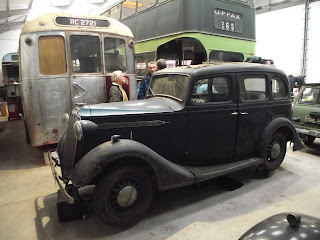LVVS 2010 open day
 |
| What have you got in your shed? Other people's work-in-progress is always fascinating |
In the end I got a good deal on rail travel (two singles were cheaper than a return and way cheaper than driving up) and went up for a couple of nights to get my fix and see the Imp in the cathedral.
 |
| As a supporter of lost causes, I was very pleased to see that someone else cares about the Austin Gypsy. |
But it's the bigger stuff that impresses. You can restore motorbikes indoors by the fire. Cars take up a lot of room when they're dismantled but buses and lorries are huge by comparison. They are simply too big for most individuals to contemplate. The answer, as shown by the LVVS, is to get like-minded individuals together so that they can pool their resources and save the stuff they like. The internet is ideal for doing this sort of thing these days although I can't think of any examples right now. Could be an opportunity here if anyone's listening. The point is, though, that the LVVS, among others, has done this already, long before the internet.
 |
| This is the interior of the Chevy coach. Note vases with flowers on the a pillars - travel was so much dignified in the thirties. Maybe I'll try this one another year. |
I would've liked to ridden in the little Chevrolet coach that served for many years in the Lake District and a pootle around in one of the society's Austin cars would hav ebeen good, too, for although I've seen loads and loads of Austin 10s and 18s, I've never ridden in one.
I did, however, manage to sample a 1946 Leyland Tiger in Southdown livery (so some way from home), a 1929 Leyland Lion LT1 with elegantly low slung Applewhite coachwork and one of my favorites the Ruston-powered Guy Arab.
 |
| When new, this 1929 Leyland Lion had concrete floor panels. Consequently, vehicles of this type were known as the Fireproof Leylands. |
The Leyland Lion was the subject of an epic restoration project. After a working life of twenty years as a bus it became a snowplough. In 1954, it was sold into preservation but langusihed outside for five years before being donated to the museum. Fortunately, the LVVS could store it under cover and there it remained for 25 year until selected for resurrection by the enlightened Lincoln City Council as part of an apprenticeship training scheme.
 |
| The Ruston powered Guy took me back into the city on the final trip of the day. |
The Ruston powered Guy was a local experiment. Originally built with a Meadows engine that was not entirely satisfactory, it subsequently acquired a secondhand Leyland unit and when this wore out the bus languished for two years until 1960 when Lincoln City fitted an 8.6 litre air cooled engine built just down the road by Ruston & Hornsby. This was originally designed for use in drag line navvies and tradition has it that the result was very noisy and liable to fry the driver with its heat but a bit of a hotrod. Having ridden on it, it didn't seem any noisier to me than its contemporaries but not so much quicker, either. In November I expect any extra engine heat was quite welcome.
All day travel cost the princely sum of £5 and services went on after darkness when a final convoy set out for an atmospheric trip back into the city. Similar events are held every Easter and November.
I never knew any of these old wagons in their heyday but it was surprisingly enjoyable wallowing in the public transport of yesteryear. Conductors insisted on giving out tickets of the era, marked ½D in some cases, and the interiors were often as striking as the exteriors with all sorts of surprising flourishes.
 |
| And so, as the light fades upon the public transport of yesteryear, it's time to think of home. |
 |
| As far as I know, Lincoln was the only place to be blighted by the presence of Imps |
The story goes that old Nick sent them out to play one windy day and they blew into the city of Lincoln where the magnificence if the cathedral was initially so awe-inspring that they behaved. But this didn't last long. They soon began tripping up vicars and threw stones at the stained glass, whereupon the angels told them to stop it. "Stop us if you can!" replied the Imps, so the angels did and turned the Imps to stone. One still exists in a pillar near the altar - not very well sign posted I might add.
 |
| Lincoln will always be associated with Imps |
It occurs to me, however, that if ever they are restoring a part of the cathedral, a gargoyle in the shape of a Hillman Imp - perhaps gushing water from its heater hose/water pump/head gasket - might be a good modern take of the Lincoln Imp.
But for well-tended, high performing Hillman Imps, which no longer suffer these problems thanks to modern techniques, sympathetic maintenance and material advances, "Stop me if you can!" is a bloody good slogan!






Comments
Post a Comment